|
       
The War on the Western Front in 1917
SPRING - The Second Battle of Arras,
FLANDERS - Battle of Messines Ridge,
Battle of Passchendaele , Battle of Cambrai
|
|
|
You are allowed to be bewildered by the multitude of names, battles and information being thrown at you. Hopefully the map will help:
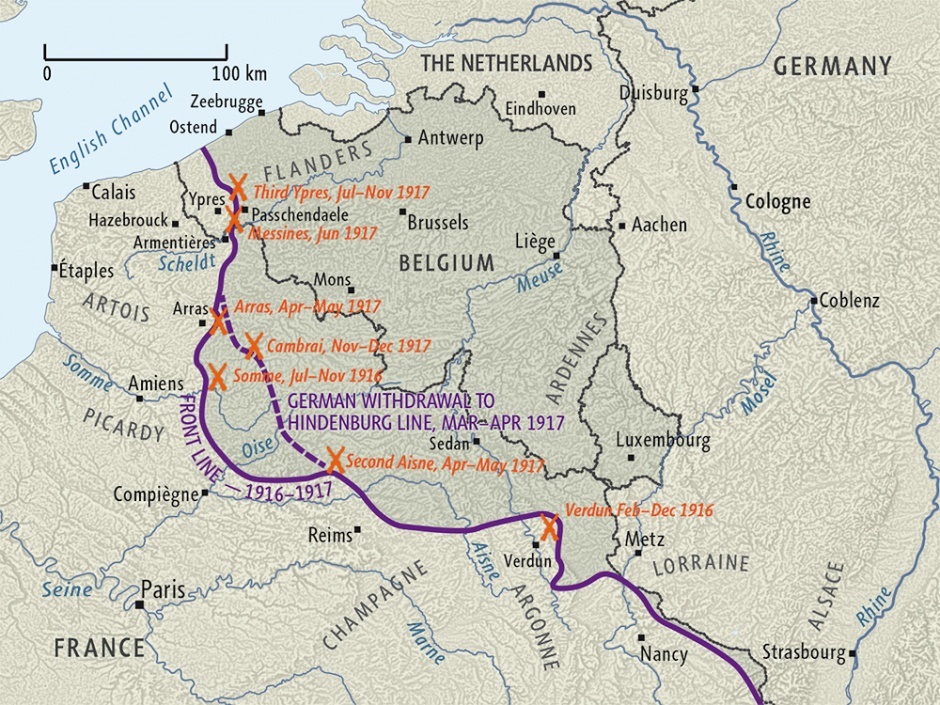
Background
The French, British and Russian planned a joint attack in Spring 1917, but this failed even before it began when the Russians pulled out, and when the Germans pulled back to the Hindenburg Line, wrecking all the attack plans. Despite all the talk of a ‘war of attrition’, commanders still aimed at a decisive breakthrough! The French General Nivelle believed he could breakthrough on the River Aisne, and he persuaded the British to mount a diversionary attack a week before – that diversionary attack was the Second Battle of Arras.
Events
Results
All this was at a cost of nearly 160,000 British casualties, and the battle bogged down into the normal pattern of pointless, costly attacks and counter-attacks over significant points of the battlefield, and Haig called it off.
|
Going Deeper
The following links will help you widen your knowledge:
Timeline
of the War in 1917
An interesting page
on Passchendaele
Debate: Was the enormous loss of life worth it?
YouTube
Two hours at Passchendaele - excellent overview of the assault
German Defence At Passchendaele - important information
|
|
There were two main reasons for these battles:
Nivelle’s Aisne Offensive (16 April to May) had been absolutely walloped, and not only that but the French soldiers in nearly half their infantry divisions on the western front started refusing to go OTT to attack. The Allied Command looked to Britain to do something to divert German attention from the French. The German U-boat campaign was causing shortages in Britain, and a successful attack along the coast would deprive them of the use of Ostend and Zeebrugge
ports. Haig hoped also that it would be the breakthrough attack to win the war.
|
Source A
War had outgrown battlefields, it had become the test of a
nation’s technology.
BBC TV series, The Great War (1964).
|
A first attack was launched at
Messines Ridge in June 1917, firstly because it
could be organised quickly, and secondly as a vantage point for the main
attack into Belgium. Again, it can be counted as a success, due to the Army Improvements: using the new tactics, including a detailed map, better spotting, mining, tanks and overhead barrage. German casualties were heavy (perhaps 25,000 casualties, but
also 7,000 taken prisoner and 3,000 missing); the Allies, however, also recorded 25,000 casualties, notably at
Hill 60.
|
|
Background
The main attack was the Third Battle of Ypres – ‘Passchendaele’. Ypres was a VERY dangerous place to attack – a salient surrounded on three sides by German artillery. The
Flandernstellung – the German system of trenches in Flanders – was especially strong. The British Prime Minister Lloyd George and the French Chief of Staff Ferdinand Foch both tried to get it cancelled until the Americans (who had declared war on Germany in April 1917) arrived. But Haig forced it through. One factor which may explain his haste was the defeat of the Russians on the Eastern Front, and the expectation that battle-hardened German troops would soon be travelling back across Europe to the Western Front.
Events
The Battle of Passchendaele was not a single
battle, but a series of battles – Pilckem Ridge, Langemarck, Menin Road,
Polygon Wood – not all unsuccessful, but all murderous, all – as shown
in the 2008 film – slogged out in deadly mud.
Results
Figures for casualties vary hugely, but it seems
clear that both sides lost at least a quarter of a million men; and the
battle is therefore regarded as an Allied success, because the German
could not afford to lose so many. Passchendaele, therefore, though conceived as a breakthrough, and which descended into a deadly stalemate, was actually key in the attrition of the German army.
|
Source B
Images of Passchedaele.
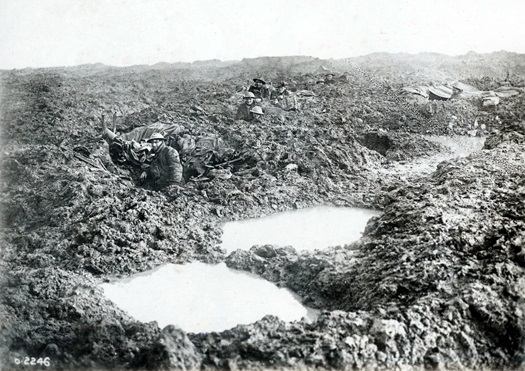
1. Archive photo of Canadian Gunners at Passchendaele (1917)
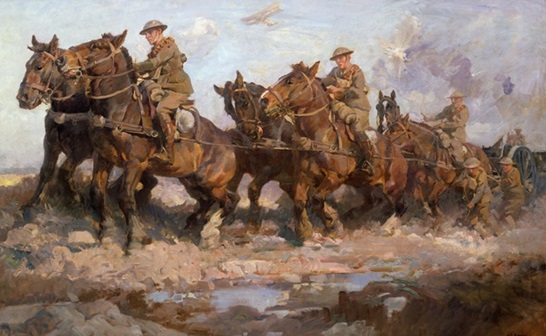
2. Bringing Up The Guns: a painting of the 101st Australian Battery
made at the time by New Zealand artists HS Power (1917)
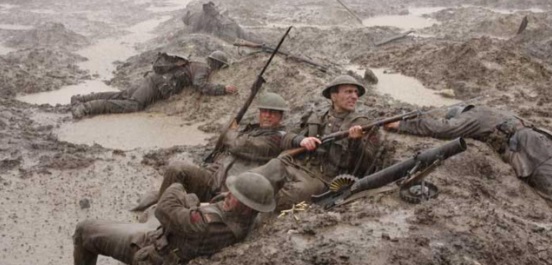
3. A still from the film Passchendaele
(2008)
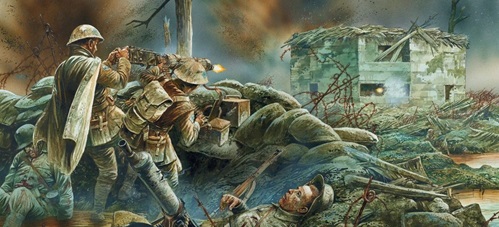
4. An artwork by Peter Dennis for Martin Pegler's
book on the Vickers-Maxim machine gun (2013)
|
Background
A third attack, was launched at
Cambrai. After the event, it was presented as a poorly-conceived operation, but it made sense because Cambrai was a major German supply and communications centre for their entire northern sector. It was conceived as a surprise attack, using 476 tanks smuggled in secretly (labelled ‘water tanks – hence the name).
The British advance used all the latest fighting techniques but – under
the artillery commander of the 9th (Scottish) infantry division Henry
Tudor – it employed the latest methods of ‘combined arms’ – all the
different combat arms working in a co-ordinated way.
Events
The first day was a brilliant success. Some German troops simply ran away, and the British advanced 5 miles. But the slow-moving tanks were easily targeted (280 were destroyed) or broke down. By the end of the first day, over half of the tanks were out of action. Then the Germans counterattacked, using their own
new ‘stormtrooper’ tactics – the British were badly defeated, and Haig
ordered the withdrawal.
Results
British casualties were about 75,000; German just over 50,000. HOWEVER, it can be argued that – with these new tactics on both sides – the battle of Cambrai marks the end of the static war of 1915-17.
|
Consider:
1. Find the evidence which shows that the British Army
was learning how to fight the war less disastrously.
2. Despite all the new tactics, there was
still no breakthrough at Passchendaele - investigate the webpage
to find some possible reasons why.
3. Taking stock: how much had been achieved by
the end of 1917 - think in terms of (a) victories won; (b)
territory captured; (c) attrition and morale.
4. Which of the four images in Source B best
conveys what it was like at Passchendaele; explain your choice.
 AQA-style Questions AQA-style Questions
1. Source B2 supports the 101st Australian Battery. How do you know?
2. How useful are Sources B1 and B2 to an historian studying the Battle of Passchendaele?
3.
Write an account of how British generals introduced new tactics in 1917.
4. ‘The leadership of the generals was the main reason for continued stalemate on the Western Front until the end of 1917.’ How far do you agree with this statement?
 iGCSE-style Questions
iGCSE-style Questions
(a) Describe TWO features of the battle of Passchendaele.
(b-c) Click to see the questions 
(b-c)
1917 marked the turning point of WWI. How far do you agree with this interpretation?
|
|
|
Spotted an error on this page? Broken link? Anything missing?
Let me know.
|
    
|





